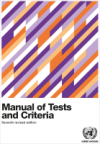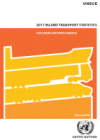Publications
Displaying Results 21 - 40 of 193
- Français
Cette publication fournit une série de tableaux de statistiques de transport pour les 56 États membres de la CEE-ONU. La publication rassemble des informations statistiques sur les transports routiers, ferroviaires et par voies navigables intérieures et a été préparée par la Division des transports durables de la CEE avec la coopération des bureaux nationaux de statistiques. Un bref résumé au
- Français
L’ADR, fait à Genève le 30 septembre 1957 sous l'égide de la Commission économique des Nations Unies pour l'Europe, est entré en vigueur le 29 janvier 1968.
Cet Accord est destiné à accroître la sécurité du transport international de marchandises dangereuses par route. Ses annexes A et B imposent les conditions dans lesquelles les marchandises dangereuses, lorsqu'elles ne sont pas interdites,
- English
Adopted on 30 September 1957 in Geneva under the auspices of the United Nations Economic Commission for Europe (UNECE), the ADR entered into force on 29 January 1968.
This authoritative Agreement is intended to increase the safety of international transport of dangerous goods by road. Its Annexes A and B contain the technical requirements for road transport, i.e. the conditions under which
- English
This publication provides comparable data on road traffic accidents in Europe, Canada and the United States. Data are organized by the nature of accident, and the number of persons killed or injured, by category or road user, age group and sex. As background data, figures on the number of road vehicles in use and vehicle-kilometers run by road vehicles are also provided along with estimates of
- English
ST/SG/AC.10/11/Rev.7
Sales No. E.20.VIII.1
ISBN 978-92-1-130394-0
eISBN 978-92-1-004503-2
Languages: E, F, (A, C, R, S forthcoming)
How to order this publication?
This publication is also available online for free (download).
The "Manual of Tests and Criteria" contains criteria, test methods and
- English
These recommendations have been developed in the light of technical progress, the advent of new substances and materials, the exigencies of modern transport systems and, above all, the requirement to ensure the safety of people, property and the environment. They are addressed to governments and international organisations concerned with the regulation of the transport of dangerous goods. The
- English
This Glossary is a joint publication of the UNECE, ITF, and Eurostat. It represents a point of reference for all those involved in transport statistics, with definitions covering infrastructure, vehicles and transport equipment, traffic and transport measurement, safety energy consumption and passenger mobility. This fifth edition is the result of collaboration between the three publishing
- Pусский
This Glossary is a joint publication of the UNECE, ITF, and Eurostat. It represents a point of reference for all those involved in transport statistics, with definitions covering infrastructure, vehicles and transport equipment, traffic and transport measurement, safety energy consumption and passenger mobility. This fifth edition is the result of collaboration between the three publishing
- Français
Le présent glossaire est une publication conjointe de la CEE, de l'ITF et d'Eurostat. Il constitue un point de référence pour tous les acteurs des statistiques des transports, avec des définitions couvrant les infrastructures, les véhicules et le matériel de transport, la mesure du trafic et des transports, la consommation énergétique de sécurité et la mobilité des passagers. Cette cinquième
- English
The GHS addresses classification of chemicals by types of hazard and proposes harmonized hazard communication elements, including labels and safety data sheets. It aims at ensuring that information on physical hazards and toxicity from chemicals be available in order to enhance the protection of human health and the environment during the handling, transport and use of these chemicals.
The GHS
- English
The European Agreement concerning the International Carriage of Dangerous Goods by Inland Waterways (ADN) done at Geneva on 26 May 2000 under the auspices of the United Nations Economic Commission for Europe (UNECE) and the Central Commission for Navigation on the Rhine (CCNR) has been in force since February 2008. The Agreement currently has eighteen Contracting Parties. The Regulations
- Français
Cette publication (volume LIX) fournit une série de tableaux statistiques sur le transport pour les 56 Etats membres de la CEE-ONU. La publication rassemble des informations statistiques sur tous les modes de transport couverts par le Comité des transports intérieurs (route et sécurité routière, rail, voies navigables intérieures et oléoducs) et a été préparée par la Division du transport durable
- English
This publication (volume LIX) provides a series of transport statistics tables for the 56 member States of UNECE. The publication brings together statistical information on all the modes of transport covered by the Inland Transport Committee (road and road safety, rail, inland waterways and oil pipelines) and has been prepared by the Sustainable Transport Division of UNECE with the generous
- English
Adopted on 30 September 1957 in Geneva under the auspices of the United Nations Economic Commission for Europe (UNECE), the ADR entered into force on 29 January 1968. This authoritative Agreement is intended to increase the safety of international transport of dangerous goods by road. Its Annexes A and B contain the technical requirements for road transport, i.e. the conditions under
- English
This publication provides comparable data on causes, types and results of accidents in Europe, Canada and the United States. Data are organized by nature of accident and surroundings; accidents while under the influence of alcohol; and the number of persons killed or injured, by category or road user and age group. As background data, figures on the number of road vehicles in use and vehicle-
- English
The GHS addresses classification of chemicals by types of hazard and proposes harmonized hazard communication elements, including labels and safety data sheets. It aims at ensuring that information on physical hazards and toxicity from chemicals be available in order to enhance the protection of human health and the environment during the handling, transport and use of these chemicals.The GHS
- English
These recommendations have been developed in the light of technical progress, the advent of new substances and materials, the exigencies of modern transport systems and, above all, the requirement to ensure the safety of people, property and the environment. They are addressed to governments and international organisations concerned with the regulation of the transport of dangerous goods. The
- English
This publication (volume LVIII) presents statistics and brief studies on transport along with tables on energy consumption for transport. Data covers Europe, Canada and the United States. Download the publication (PDF)
- English
The European Agreement concerning the International Carriage of Dangerous Goods by Inland Waterways (ADN) done at Geneva on 26 May 2000 under the auspices of the United Nations Economic Commission for Europe (UNECE) and the Central Commission for Navigation on the Rhine (CCNR) has been in force since February 2008. The Agreement currently has eighteen Contracting Parties.The Regulations
- English
Adopted on 30 September 1957 in Geneva under the auspices of the United Nations Economic Commission for Europe (UNECE), the ADR entered into force on 29 January 1968.This authoritative Agreement is intended to increase the safety of international transport of dangerous goods by road. Its Annexes A and B contain the technical requirements for road transport, i.e. the conditions under which


















